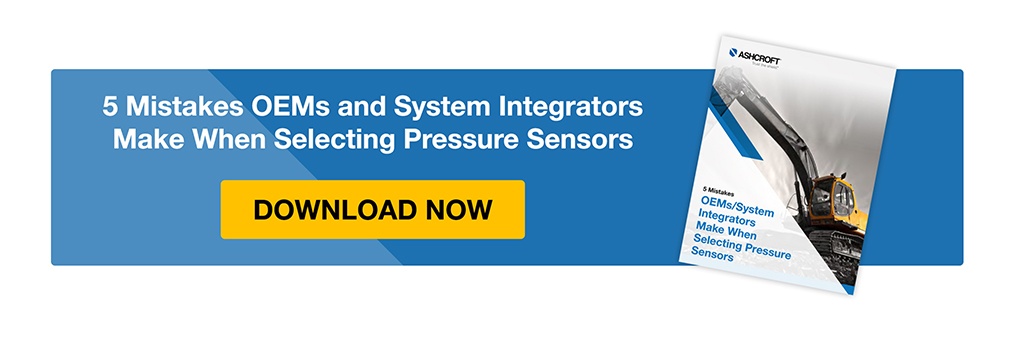
By:
Todd McPadden
Product Sales Leader, High Pressure Transducers
Published on:
January 20th, 2025
Subscribe now and get the latest blog posts delivered straight to your inbox.
What are Ingress Protection (IP) Ratings for Pressure Sensors?

By:
Todd McPadden
Product Sales Leader, High Pressure Transducers
Published on:
January 20th, 2025

When selecting pressure sensors for specific applications, it's important to understand the instrument's Ingress Protection (IP) rating. IP Ratings, which are also referred to as International Protection Ratings, determine the sensor's ability to withstand environmental factors such as moisture, dust and debris. These elements are commonly encountered in off-road vehicles, construction equipment, agricultural systems and other applications, and can significantly impact the performance and longevity of your pressure instruments.
As a product manager at Ashcroft, a leading manufacturer of pressure and temperature instruments, I am often asked about which IP ratings are needed for instruments used in OEM applications. The answer depends on many factors. Read this article to learn more about the components of an IP rating, the factors that influence rating requirements and the applications covered in each category.
When you are done reading, you will also find additional resources that may help you select the best IP-rated pressure sensor for your application.
What is an IP rating?
International Electrotechnical Commission (IEC) developed the IEC 60529 to standardize the way manufacturers classify the level of ingress protection offered by the enclosures of electrical equipment, including pressure sensors. The two-digit rating code indicates how much protection the instrument provides to prevent any liquids and solids from entering your application:
- The first number signifies the level of protection from solid objects, including dust, debris, or other materials
- The second represents the level of protection for liquids, including water, oil and chemicals
If an "X" appears in place of the solid or liquid number, it means the instrument is not rated for that specific category.
Figure 1. IP Ratings Chart

When you select instruments with the applicable IP designation, you can be confident they will be sufficiently protected and operate effectively in their intended environment, whether that is a controlled indoor space or outdoor location.
As an example, instruments like the Ashcroft® E2 Pressure Sensors with a well-sealed connector can offer total protection against dust and can withstand periods of full immersion. That gives it an IP rating of 67.
Selecting the right electrical connections is an important factor in determining the sensor's ingress rating because it directly influences the instrument's ability to block environmental contaminants. A less secure connection may receive a lower rating, like IP54, indicating the electrical enclosure provides limited protection against dust ingress and can only withstand splashing water.
Other factors that influence IP rating requirements.
To ensure optimal performance and durability of your pressure sensors, you need to consider the application and the environmental conditions (exposure to potential contaminants) where the sensors will be used. Depending on the application, you can have low, moderate and high IP ratings. Here are a few examples:
- Low IP Ratings (e.g., IP20, IP40) are suitable for indoor, controlled environments
- Moderate IP Ratings (e.g., IP54, IP64) are more suitable for semi-protected environments, including automotive and HVAC where sensors encounter water splashes and dust
- High IP Ratings (e.g., IP65, IP67, IP69K) are best for use in challenging environments, such as marine, industrial and agricultural where equipment must endure outdoor conditions including water, dust and other contaminants.
Here are a few more factors to consider when looking for a pressure sensor with the appropriate IP rating:
- Operational demands of the application. Does your system require the sensor to endure high frequency and intensity?
- Industry standards and regulations. What are the requirements for using these instruments to ensure compliance and safety for your operation and your operators?
- Geographical location. What are the climate and weather patterns that can dictate the level of protection needed to withstand extreme temperatures, humidity, or precipitation?
Understanding all of these factors can help you choose pressure sensors with the right IP rating for your needs. Doing so will not only protect your instruments, it will also help keep them working over time.
Pressure sensor testing
Pressure sensors like the Ashcroft® G2 Pressure Transducer and the Ashcroft® S1 OEM Pressure Transducer undergo a variety of common tests to verify their performance and durability. These tests often include:
- Environmental simulations expose the sensors to conditions such as extreme temperatures, humidity, and pressure variations.
- Vibration and shock tests to assess the sensor's ability to maintain accuracy and functionality under mechanical stress.
- Chemical resistance ensures the sensors can operate effectively in environments where they might be exposed to corrosive substances.
Ready to learn more about choosing the right pressure sensor?
Transducers and transmitters play an important role in the success and safety of your systems. The more you know about how the sensors work and what can affect their performance, the more prepared you will be to take the necessary steps to address challenges like freeze protection in the future.
Here are a few more related articles that may interest you:
- Can a Pressure Transducer Get Damaged by Freezing Water?
- How Does Media Temperature Affect Pressure Transducer Performance?
- What Makes OEM Pressure Sensors Accurate and Repeatable?
Or, reach out today to talk to one of our industry experts and get all your pressure transducer questions answered.
In the meantime, download our guide to learn more about the Ashcroft® S1 Pressure Transducer, an effective and reliable solution for mobile hydraulics, performance racing, all-terrain vehicles, agriculture, refrigeration and more. 
Todd McPadden, Product Sales Leader, High Pressure Transducers
Todd is the product manager for OEM High-Pressure Transducers with more than 19 years of experience at Ashcroft.


























